Mitsubishi Electronics FR-E740-0.4KSC, FR-E720S-0.1KSC, FR-E720-0.1KSC User Manual
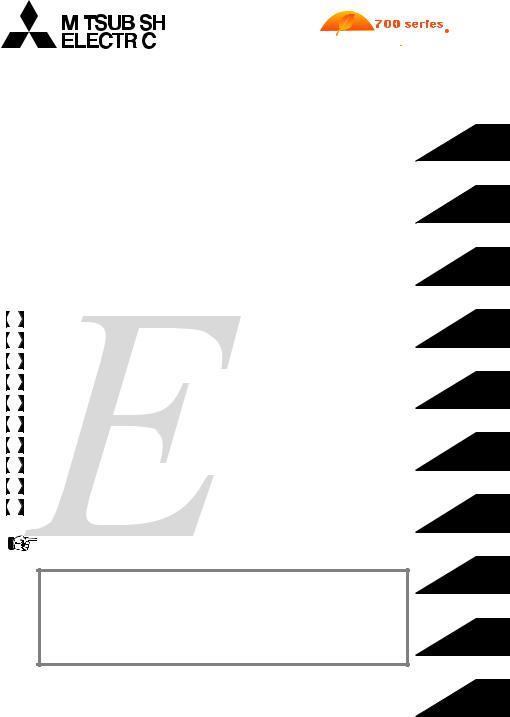
|
|
|
|
|
|
|
|
|
|
|
|
|
|
|
|
|
|
|
|
|
|
|
|
|
|
|
|
|
|
|
|
|
|
INVERTER |
|
|
|
|
|
|
|
|
|
|
|
|
|
|
|
|
|
|
|
|
|
|
|
|
|
|
|
|
|
|
|
||
|
|
|
|
|
|
|
|
|
|
|
|
|
|
|||
|
|
|
|
|
|
|
|
|
|
|
||||||
|
|
|
|
|
|
|||||||||||
FR-E700 |
|
|
|
|||||||||||||
INSTRUCTION MANUAL (BASIC) |
|
|
|
|||||||||||||
1 |
||||||||||||||||
FR-E720-0.1KSC to 15KSC |
|
|
|
|
||||||||||||
FR-E740-0.4KSC to 15KSC |
|
|
|
|||||||||||||
FR-E720S-0.1KSC to 2.2KSC |
2 |
|||||||||||||||
|
|
|
|
|
|
|
|
|
|
|
|
|
|
|
|
|
Thank you for choosing this Mitsubishi Inverter.
This Instruction Manual (Basic) provides handling information and precautions for use of the equipment. Please forward this Instruction Manual (Basic) to the end user.
|
CONTENTS |
|
1 |
OUTLINE ................................................................................... |
1 |
2 |
INSTALLATION AND WIRING ................................................... |
6 |
3 |
PRECAUTIONS FOR USE OF THE INVERTER......................... |
20 |
4 |
FAILSAFE OF THE SYSTEM WHICH USES THE INVERTER ... |
22 |
5 |
DRIVING THE MOTOR............................................................. |
23 |
6 |
ENERGY SAVING OPERATION FOR FANS AND PUMPS ........ |
33 |
7 |
PARAMETERS ......................................................................... |
34 |
8 |
TROUBLESHOOTING .............................................................. |
39 |
9 |
PRECAUTIONS FOR MAINTENANCE AND INSPECTION ........ |
44 |
10 |
SPECIFICATIONS.................................................................... |
46 |
|
To obtain the Instruction Manual (Applied) and the |
|
|
manual |
|
|
Safety stop function instruction700 |
|
Contact where you purchased the inverter, your Mitsubishi sales representative, or the nearest Mitsubishi FA Center for the following manual:
Instruction Manual (Applied) [IB(NA)-0600277ENG]
Safety stop function instruction manual [BCN-A211508-004]
These manuals are required if you are going to utilize functions and performance.
The PDF versions of these manuals are also available for download at "MELFANS Web," the Mitsubishi Electric FA network service on the world wide web (URL: http://www.MitsubishiElectric.co.jp/melfansweb).
 3
3
 4
4
 5
5
 6
6
 7
7
 8
8
 9
9
10

This Instruction Manual (Basic) provides handling information and precautions for use of the equipment. Please forward this Instruction Manual (Basic) to the end user.
This section is specifically about safety matters
Do not attempt to install, operate, maintain or inspect the inverter until you have read through the Instruction Manual (Basic) and appended documents carefully and can use the equipment correctly. Do not use this product until you have a full knowledge of the equipment, safety information and instructions.
In this Instruction Manual (Basic), the safety instruction levels are classified into "WARNING" and "CAUTION".
WARNING Incorrect handling may cause hazardous conditions, resulting in
death or severe injury.
CAUTION |
Incorrect handling may cause |
hazardous conditions, resulting in |
|
|
medium or slight injury, or may cause |
|
only material damage. |
The CAUTION |
level may even lead to a serious |
consequence according to conditions. Both instruction levels must be followed because these are important to personal safety.
1. Electric Shock Prevention
 WARNING
WARNING
While power is ON or when the inverter is running, do not open the front cover. Otherwise you may get an electric shock.
Do not run the inverter with the front cover or wiring cover removed. Otherwise you may access the exposed highvoltage terminals or the charging part of the circuitry and get an electric shock.
Even if power is OFF, do not remove the front cover except for wiring or periodic inspection. You may accidentally touch the charged inverter circuits and get an electric shock.
Before wiring or inspection, power must be switched OFF. To confirm that, LED indication of the operation panel must be checked. (It must be OFF.) Any person who is involved in wiring or inspection shall wait for at least 10 minutes after the power supply has been switched OFF and check that there are no residual voltage using a tester or the like. The capacitor is charged with high voltage for some time after power OFF, and it is dangerous.
This inverter must be earthed (grounded). Earthing (grounding) must conform to the requirements of national and local safety regulations and electrical code (NEC section 250, IEC 536 class 1 and other applicable standards).
A neutral-point earthed (grounded) power supply for 400V class inverter in compliance with EN standard must be used.
Any person who is involved in wiring or inspection of this equipment shall be fully competent to do the work.
The inverter must be installed before wiring. Otherwise you may get an electric shock or be injured.
Setting dial and key operations must be performed with dry hands to prevent an electric shock.
Do not subject the cables to scratches, excessive stress, heavy loads or pinching. Otherwise you may get an electric shock.
Do not change the cooling fan while power is ON. It is dangerous to change the cooling fan while power is ON.
Do not touch the printed circuit board or handle the cables with wet hands. Otherwise you may get an electric shock.
When measuring the main circuit capacitor capacity, the DC voltage is applied to the motor for 1s at powering OFF. Never touch the motor terminal, etc. right after powering OFF to prevent an electric shock.
2. Fire Prevention
 CAUTION
CAUTION
Inverter must be installed on a nonflammable wall without holes (so that nobody touches the inverter heatsink on the rear side, etc.). Mounting it to or near flammable material can cause a fire.
If the inverter has become faulty, the inverter power must be switched OFF. A continuous flow of large current could cause a fire.
When using a brake resistor, a sequence that will turn OFF power when a fault signal is output must be configured. Otherwise the brake resistor may overheat due to damage of the brake transistor and possibly cause a fire.
Do not connect a resistor directly to the DC terminals P/+ and N/-. Doing so could cause a fire.
3.Injury Prevention
 CAUTION
CAUTION
The voltage applied to each terminal must be the ones specified in the Instruction Manual. Otherwise burst, damage, etc. may occur.
The cables must be connected to the correct terminals. Otherwise burst, damage, etc. may occur.
Polarity must be correct. Otherwise burst, damage, etc. may occur.
While power is ON or for some time after power-OFF, do not touch the inverter as they will be extremely hot. Doing so can cause burns.
4.Additional Instructions
Also the following points must be noted to prevent an accidental failure, injury, electric shock, etc.
(1) Transportation and Mounting
 CAUTION
CAUTION
The product must be transported in correct method that corresponds to the weight. Failure to do so may lead to injuries.
Do not stack the boxes containing inverters higher than the number recommended.
The product must be installed to the position where withstands the weight of the product according to the information in the Instruction Manual.
Do not install or operate the inverter if it is damaged or has parts missing.
When carrying the inverter, do not hold it by the front cover or setting dial; it may fall off or fail.
Do not stand or rest heavy objects on the product.
The inverter mounting orientation must be correct.
Foreign conductive objects must be prevented from entering the inverter. That includes screws and metal fragments or other flammable substance such as oil.
As the inverter is a precision instrument, do not drop or subject it to impact.
The inverter must be used under the following environment. Otherwise the inverter may be damaged.
|
Surrounding |
-10°C to +50°C (non-freezing) |
|
|
air |
||
Environment |
temperature |
|
|
Ambient |
90%RH or less (non-condensing) |
||
humidity |
|||
|
|||
Storage |
-20°C to +65°C *1 |
||
temperature |
|||
Atmosphere |
Indoors (free from corrosive gas, flammable gas, |
||
|
|
oil mist, dust and dirt) |
|
|
Altitude/ |
Maximum 1,000m above sea level. |
|
|
5.9m/s2 or less at 10 to 55Hz (directions of X, Y, Z |
||
|
vibration |
axes) |
|
|
|
1 Temperature applicable for a short time, e.g. in transit.
A-1

(2) Wiring
 CAUTION
CAUTION
Do not install a power factor correction capacitor or surge suppressor/capacitor type filter on the inverter output side. These devices on the inverter output side may be overheated or burn out.
The connection orientation of the output cables U, V, W to the motor affects the rotation direction of the motor.
(3) Trial run
 CAUTION
CAUTION
Before starting operation, each parameter must be confirmed and adjusted. A failure to do so may cause some machines to make unexpected motions.
(4) Usage
 WARNING
WARNING
Any person must stay away from the equipment when the retry function is set as it will restart suddenly after trip.
Since pressing  key may not stop output depending on the function setting status, separate circuit and switch that make an emergency stop (power OFF, mechanical brake operation for emergency stop, etc.) must be provided.
key may not stop output depending on the function setting status, separate circuit and switch that make an emergency stop (power OFF, mechanical brake operation for emergency stop, etc.) must be provided.
OFF status of the start signal must be confirmed before resetting the inverter fault. Resetting inverter alarm with the start signal ON restarts the motor suddenly.
The inverter must be used for three-phase induction motors. Connection of any other electrical equipment to the inverter output may damage the equipment.
Do not modify the equipment.
Do not perform parts removal which is not instructed in this manual. Doing so may lead to fault or damage of the product.
 CAUTION
CAUTION
The electronic thermal relay function does not guarantee protection of the motor from overheating. It is recommended to install both an external thermal and PTC thermistor for overheat protection.
Do not use a magnetic contactor on the inverter input for frequent starting/stopping of the inverter. Otherwise the life of the inverter decreases.
The effect of electromagnetic interference must be reduced by using a noise filter or by other means. Otherwise nearby electronic equipment may be affected.
Appropriate measures must be taken to suppress harmonics. Otherwise power supply harmonics from the inverter may heat/damage the power factor correction capacitor and generator.
When driving a 400V class motor by the inverter, the motor must be an insulation-enhanced motor or measures must be taken to suppress surge voltage. Surge voltage attributable to the wiring constants may occur at the motor terminals, deteriorating the insulation of the motor.
When parameter clear or all parameter clear is performed, the required parameters must be set again before starting operations because all parameters return to the initial value.
The inverter can be easily set for high-speed operation. Before changing its setting, the performances of the motor and machine must be fully examined.
Stop status cannot be hold by the inverter's brake function. In addition to the inverter’s brake function, a holding device must be installed to ensure safety.
Before running an inverter which had been stored for a long period, inspection and test operation must be performed.
For prevention of damage due to static electricity, nearby metal must be touched before touching this product to eliminate static electricity from your body.
(5) Emergency stop
 CAUTION
CAUTION
A safety backup such as an emergency brake must be provided to prevent hazardous condition to the machine and equipment in case of inverter failure.
When the breaker on the inverter input side trips, the wiring must be checked for fault (short circuit), and internal parts of the inverter for a damage, etc. The cause of the trip must be identified and removed before turning ON the power of the breaker.
When any protective function is activated, appropriate corrective action must be taken, and the inverter must be reset before resuming operation.
(6) Maintenance, inspection and parts replacement
 CAUTION
CAUTION
Do not carry out a megger (insulation resistance) test on the control circuit of the inverter. It will cause a failure.
(7) Disposal
 CAUTION
CAUTION
The inverter must be treated as industrial waste.
General instruction
Many of the diagrams and drawings in this Instruction Manual (Basic) show the inverter without a cover or partially open for explanation. Never operate the inverter in this manner. The cover must be always reinstalled and the instruction in this Instruction Manual (Basic) must be followed when operating the inverter.
A-2

<Abbreviation>
PU: Operation panel and parameter unit (FR-PU04, FR-PU07)
Inverter: Mitsubishi inverter FR-E700 series safety stop function model
FR-E700: Mitsubishi inverter FR-E700 series safety stop function model
Pr.: Parameter number (Number assigned to function)
PU operation: Operation using the PU (operation panel/FR-PU04/FR-PU07)
External operation: Operation using the control circuit signals
Combined operation : Operation using the PU (FR-PU04/FR-PU07) and external operation
Standard motor : SF-JR
Constant torque motor : SF-HRCA
<Trademark>
LONWORKS® is a registered trademark of Echelon Corporation in the U.S.A and other countries.
Company and product names herein are the trademarks and registered trademarks of their respective owners.
<Mark>

 REMARKS: Additional helpful contents and relations with other functions are written.
REMARKS: Additional helpful contents and relations with other functions are written.
Note: Contents requiring caution or cases when set functions are not activated are written.
 POINT: Useful contents and points are written.
POINT: Useful contents and points are written.
<Related document>
 Refer to the Instruction Manual (Applied) for further information on the following points.
Refer to the Instruction Manual (Applied) for further information on the following points.
Removal and reinstallation of the cover
Connection of stand-alone option unit
EMC and leakage currents
Detailed explanation on parameters
Troubleshooting
Check first when you have a trouble
Inspection items (life diagnosis, cooling fan replacement)
Measurement of main circuit voltages, currents and powers
For customers who are replacing the conventional model with this inverter
A-3
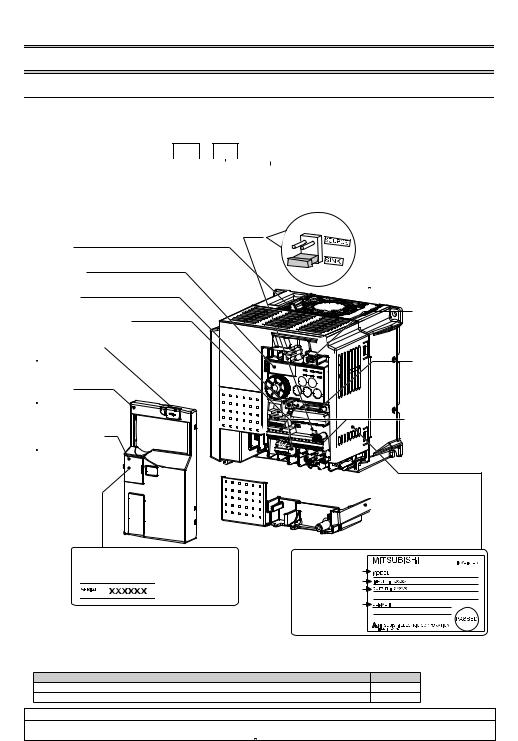
Product checking and parts identification 
1 OUTLINE
1.1Product checking and parts identification
Unpack the inverter and check the capacity plate on the front cover and the rating plate on the inverter side face to ensure that the product agrees with your order and the inverter is intact.
Inverter model
|
FR - |
E740 |
- |
||
|
|
|
|
|
|
No. |
Voltage class |
|
|||
E720 |
Three-phase 200V class |
|
|||
|
|
|
|||
E740 |
Three-phase 400V class |
|
|||
|
|
|
|||
E720S |
Single-phase 200V class |
|
|||
|
|
|
|
|
|
Cooling fan
The cooling fan is removable.
Operation panel
3.7 K SC
|
|
|
|
|
|
|
|
|
|
|
1 |
|
|
|
|
|
|
|
|
|
|
|
|
Represents the |
|
Symbol |
Control circuit terminal specification |
|
|||||||
|
|
SC |
Safety stop function model |
|
|||||||
inverter capacity [kW] |
|
|
|
|
|||||||
|
|
|
|
|
|
|
|
|
|
|
|
Control logic switchover jumper connector
The jumper connector is in the sink logic (SINK) when shipped from the factory. Move the jumper connector to change to the source logic (SOURCE). Always fit the jumper connector to the either position.
(Refer to page 2)
PU connector
(Refer to page 9)
Voltage/current input switch
(Refer to page 9)
USB connector cover
 Refer to the Instruction Manual (Applied) for how to open the cover.
Refer to the Instruction Manual (Applied) for how to open the cover.
Front cover
 Refer to the Instruction Manual (Applied) for installation/removal.
Refer to the Instruction Manual (Applied) for installation/removal.
PU connector cover
 Refer to the Instruction Manual (Applied) for how to open the cover.
Refer to the Instruction Manual (Applied) for how to open the cover.
(  Refer to the Instruction Manual (Applied))
Refer to the Instruction Manual (Applied))
USB connector (mini-B connector)
(Refer to page 9)
Connector for plug-in option connection
(Refer to the instruction manual of options.)
Control circuit terminal block
(Refer to page 10)
 Main circuit terminal block
Main circuit terminal block
(Refer to page 10)
 Combed shaped wiring cover
Combed shaped wiring cover
Refer to the Instruction Manual (Applied) for installation/removal.
Capacity plate
FR-E740-3.7KSC Inverter model
Inverter model
 Serial number
Serial number
Example of FR-E740-3.7KSC |
|
Rating plate |
|
Inverter model |
FR-E740-3.7KSC |
Input rating |
|
Output rating |
|
Serial number |
|
Accessory
·Fan cover fixing screws (M3 35mm)
These screws are necessary for compliance with the EU Directive (Refer to page 49)
Capacity |
Quantity |
FR-E720-1.5KSC to 3.7KSC, FR-E740-1.5KSC to 3.7KSC, FR-E720S-0.75KSC to 2.2KSC |
1 |
FR-E720-5.5KSC to 15KSC, FR-E740-5.5KSC to 15KSC |
2 |
Harmonic suppression guideline (when inverters are used in Japan)
All models of general-purpose inverters used by specific consumers are covered by "Harmonic suppression guideline for consumers who receive high voltage or special high voltage". (For further details,  refer to Chapter 3 of the Instruction Manual (Applied).)
refer to Chapter 3 of the Instruction Manual (Applied).)
1
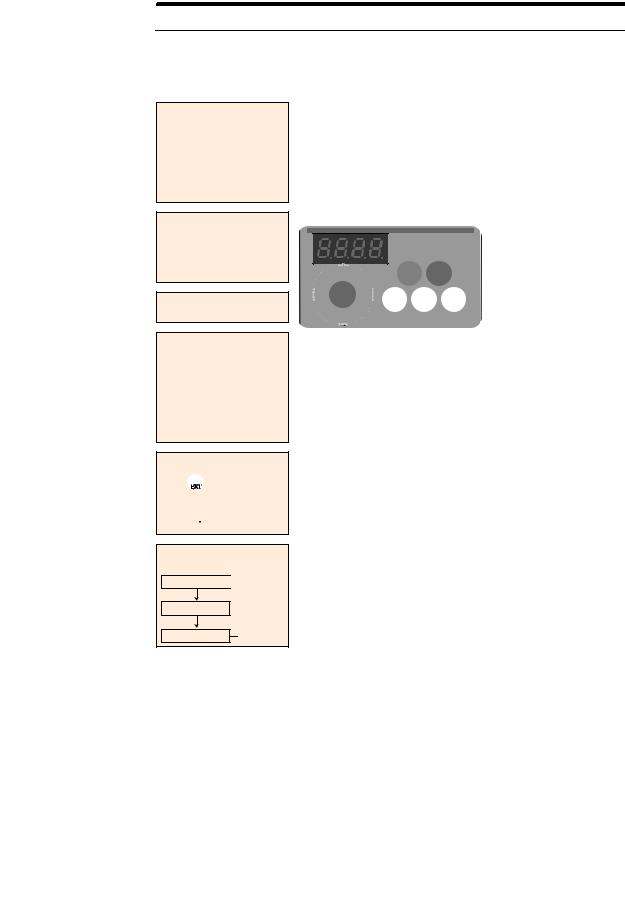
 Operation panel
Operation panel
1.2Operation panel
1.2.1Names and functions of the operation panel
The operation panel cannot be removed from the inverter.
Operation mode indicator
PU: Lit to indicate PU operation mode. EXT: Lit to indicate External operation mode.
(Lit at power-ON at initial setting.) NET: Lit to indicate Network operation
mode.
PU, EXT: Lit to indicate External/PU combined operation mode 1, 2.
These turn OFF when command source is not on operation panel.
Unit indicator
Hz: Lit to indicate frequency. (Flickers when the set frequency monitor is displayed.)
A: Lit to indicate current.
(Both "Hz" and "A" turn OFF when other than the above is displayed.)
Monitor (4-digit LED)
Shows the frequency, parameter number, etc.
Setting dial
(Setting dial: Mitsubishi inverter dial) Used to change the frequency setting and parameter settings.
Press to display the following.
Displays the set frequency in the monitor mode
Present set value is displayed during calibration
Displays the order in the faults history mode
Mode switchover
Used to change each setting mode. Pressing  simultaneously changes
simultaneously changes
the operation mode.
Pressing for a while (2s) can lock operation. ( Refer to the Instruction Manual (Applied))
Refer to the Instruction Manual (Applied))
Determination of each setting
If pressed during operation, monitor changes as below:
Running frequency 
 Operating status indicator
Operating status indicator
Lit or flicker during inverter operation.
* Lit: When the forward rotation operation is being performed.
Slow flickering (1.4s cycle):
When the reverse operation is being performed.
Fast flickering (0.2s cycle):
When  was pressed or the
was pressed or the
start command was given, but the operation cannot be made.
When the frequency command is less than the starting frequency.
When the MRS signal is input.
 Parameter setting mode
Parameter setting mode
Lit to indicate parameter setting mode.
Monitor indicator
Lit to indicate monitoring mode.
 Stop operation
Stop operation
Used to stop Run command. Fault can be reset when protective function is activated (fault).
 Operation mode switchover
Operation mode switchover
Used to switch between the PU and External operation mode.
When using the External operation mode (operation using a separately connected frequency setting potentiometer and start signal), press this key to light up the EXT indication.
(Press  simultaneously (0.5s) or
simultaneously (0.5s) or
change Pr. 79 setting to change to combined mode .) ( Refer to the Instruction Manual (Applied))
Refer to the Instruction Manual (Applied))
PU: PU operation mode EXT: External operation mode Cancels PU stop also.
 Start command
Start command
The rotation direction can be selected by setting Pr. 40.
Output current
Output voltage
2
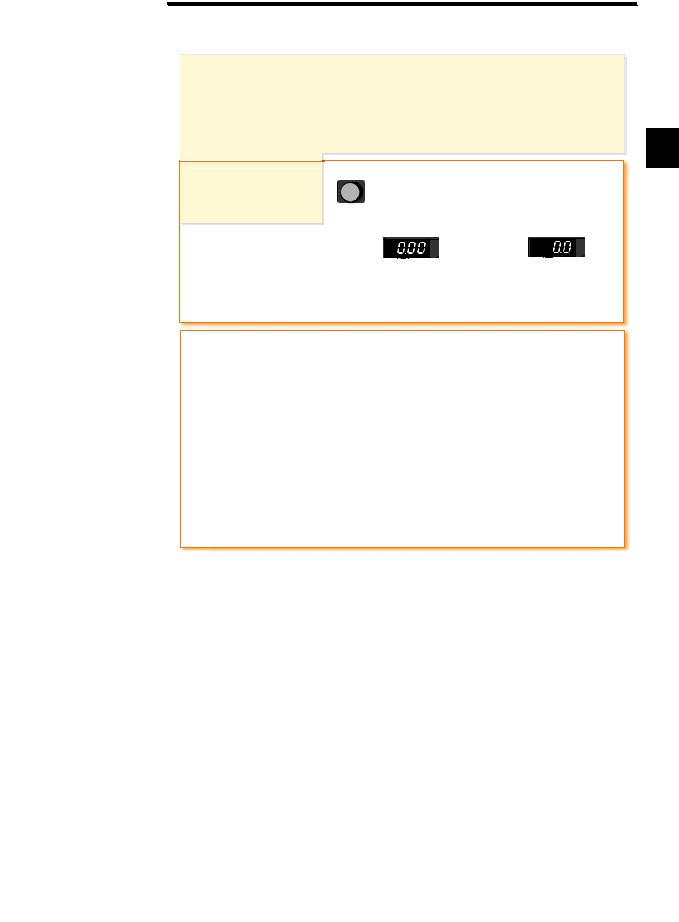
Operation panel 
1.2.2Basic operation (factory setting)
Monitor/frequency setting
Operation mode switchover
At power-ON (External operation mode)
|
PU Jog operation mode |
1 |
|
|
|
(Example) |
|
PU operation mode |
Value change |
and frequency flicker. |
|
(output frequency monitor) |
|||
|
|
||
|
|
Frequency setting has been |
|
|
|
written and completed!! |
|
|
Output current monitor STOP |
Output voltage monitor |
|
|
|
Parameter setting
Faults history
Parameter setting mode (Refer to page 4) |
|
Display the |
|
present setting |
|
|
|
(Example) |
Value change |
|
Parameter and a setting value |
|
|
flicker alternately. |
|
|
Parameter write is completed!! |
Parameter clear |
All parameter |
Faults history clear |
|
clear |
|
Initial value change list
[Operation for displaying faults history] (Refer to page 40)
Past eight faults can be displayed. (The latest fault is ended by ".".)
When no fault history exists, 







 is displayed.
is displayed.
While a fault is displayed:
The display shifts as follows by pressing 

 : Output frequency at the fault
: Output frequency at the fault Output current
Output current Output voltage
Output voltage Energization time.
Energization time.
(After Energization time, it goes back to a fault display.)
Pressing the setting dial shows the fault history number.
3
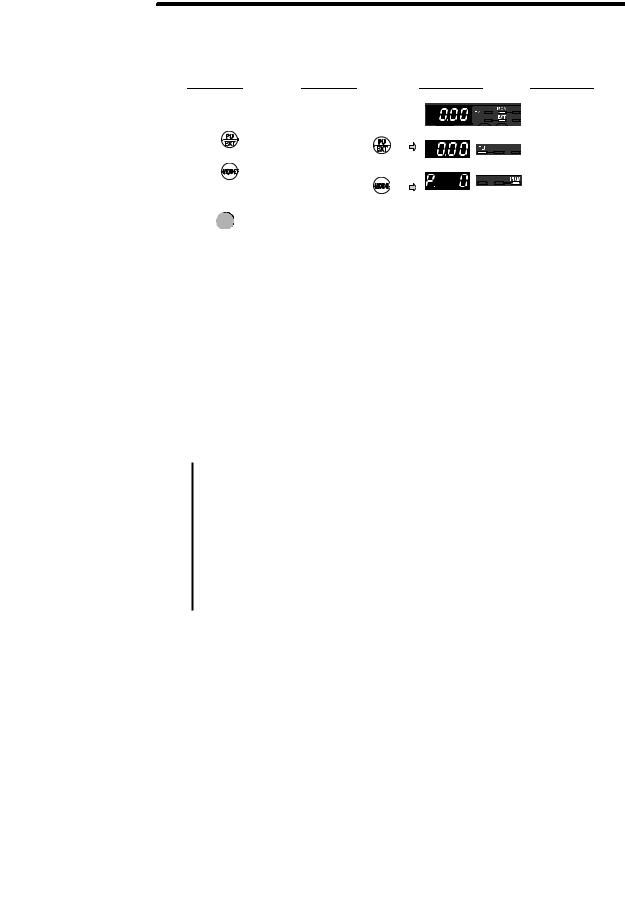
 Operation panel
Operation panel
1.2.3Changing the parameter setting value
Changing |
Change the Pr. 1 Maximum frequency setting. |
|
example |
||
|
|
Operation |
Display |
|
1. Screen at power-ON |
|
|
|
The monitor display appears. |
|
||
2. Press |
to choose the PU operation mode. |
PU indicator is lit. |
|
|
|||
3. Press |
to choose the parameter setting |
PRM indicator is lit. |
|
|
|||
mode. |
|
|
(The parameter number read previously appears.) |
|
|
|
|
4. Turn |
until |
(Pr. 1) appears. |
|
5. Press  to read the currently set value. "
to read the currently set value. " 




 "(120.0Hz (initial value)) appears.
"(120.0Hz (initial value)) appears.
6. Turn  to change the set value to "
to change the set value to " 





 " (60.00Hz).
" (60.00Hz).
7. Press  to set.
to set.
Flicker...Parameter setting complete!!
Turn  to read another parameter.
to read another parameter.
Press  to show the setting again.
to show the setting again.
Press  twice to show the next parameter.
twice to show the next parameter.
Press  twice to return the monitor to frequency monitor.
twice to return the monitor to frequency monitor.

 REMARKS
REMARKS
|
to |
|
...is displayed Why? |
|
appears .................... |
Write disable error |
|
|
appears .................... |
Write error during operation |
|
|
appears .................... |
Calibration error |
|
|
appears .................... |
Mode designation error |
|
(For details,  Refer to the Instruction Manual (Applied).)
Refer to the Instruction Manual (Applied).)
The number of digits displayed on the operation panel is four. Only the upper four digits of values can be displayed and set. If the values to be displayed have five digits or more including decimal places, the fifth or later numerals can not be displayed nor set. (Example) For Pr. 1
When 60Hz is set, 60.00 is displayed.
When 120Hz is set, 120.0 is displayed and second decimal place is not displayed nor set.
4
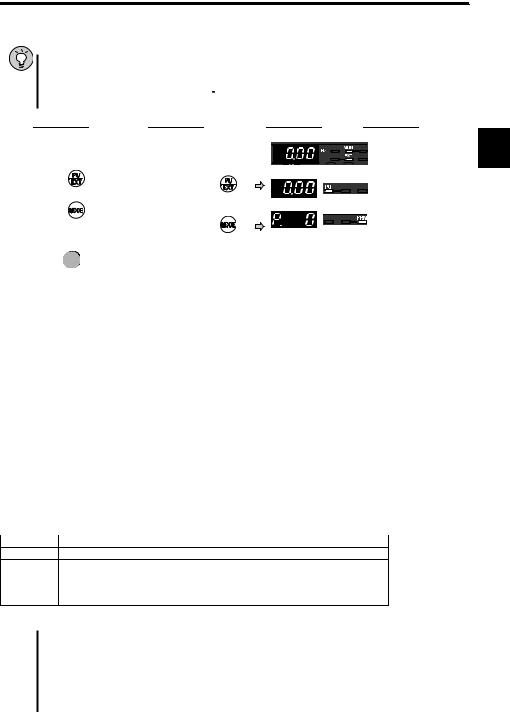
Operation panel 
1.2.4Parameter clear/all parameter clear
POINT
Set "1" in Pr.CL Parameter clear, ALLC all parameter clear to initialize all parameters. (Parameters are not cleared when "1" is set in Pr. 77 Parameter write selection.)
Refer to the extended parameter list of  the Instruction Manual (Applied) for parameters cleared with this operation.
the Instruction Manual (Applied) for parameters cleared with this operation.
|
Operation |
|
Display |
|
1. Screen at power-ON |
|
|
1 |
|
The monitor display appears. |
|
|||
|
|
|||
2. Press |
to choose the PU operation mode. |
PU indicator is lit. |
||
|
||||
3. Press |
to choose the parameter setting |
PRM indicator is lit. |
||
|
||||
mode. |
|
|
|
(The parameter number read previously appears.) |
|
|
|
|
|
4. Turn |
until |
( |
) appears. |
Parameter clear |
|
||||
|
|
|
|
All parameter clear |
5. Press  to read the currently set value. "
to read the currently set value. " 
 "(initial value) appears.
"(initial value) appears.
6. Turn  to change it to the set value "
to change it to the set value "  ".
".
7. Press |
to set. |
Parameter clear |
|
||
|
|
All parameter clear |
Flicker ··· Parameter setting complete!!
Turn  to read another parameter.
to read another parameter.
Press  to show the setting again.
to show the setting again.
Press  twice to show the next parameter.
twice to show the next parameter.
Setting |
Description |
0Not executed.
Sets parameters back to the initial values. (Parameter clear sets back all parameters except
1
calibration parameters and terminal function selection parameters to the initial values.) Refer to the parameter list of  the Instruction Manual (Applied) for availability of parameter clear and all parameter clear.
the Instruction Manual (Applied) for availability of parameter clear and all parameter clear.

 REMARKS
REMARKS










 and
and 







 are displayed alternately ... Why?
are displayed alternately ... Why?
 The inverter is not in the PU operation mode.
The inverter is not in the PU operation mode.
 PU connector or USB connector is used.
PU connector or USB connector is used.
1.Press  . [PU] is lit and the monitor (4-digit LED) displays "1". (When Pr. 79 = "0" (initial value))
. [PU] is lit and the monitor (4-digit LED) displays "1". (When Pr. 79 = "0" (initial value))
2.Carry out operation from step 6 again.
5
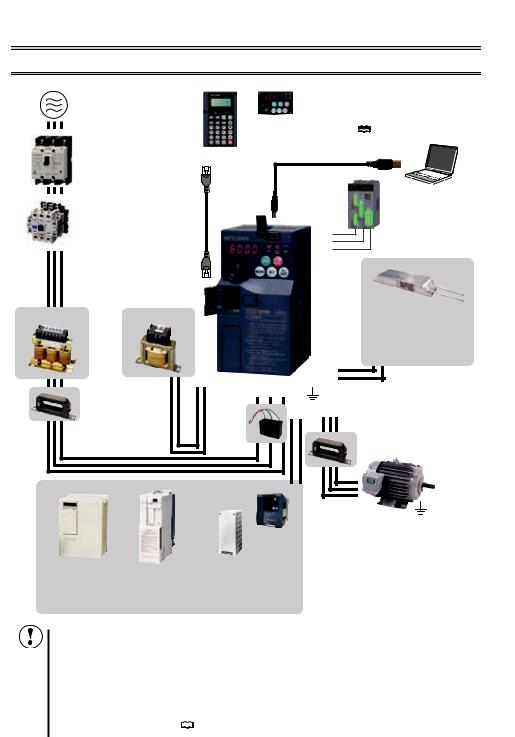
2 INSTALLATION AND WIRING
AC power supply |
|
|
|
|
|
|
|
|
Use within the permissible power supply |
|
|
|
|
|
USB connector |
||
specifications of the inverter. To ensure |
|
|
|
|
|
A personal computer and an inverter |
||
safety, use a moulded case circuit breaker, |
|
|
|
|
||||
|
|
|
|
can be connected with a |
||||
earth leakage circuit breaker or magnetic |
|
|
|
|
|
|||
|
|
|
Enclosure surface operation panel |
USB (Ver1. 1) cable. |
||||
contactor to switch power ON/OFF. |
|
|
|
|||||
(Refer to page 46) |
|
|
|
(FR-PA07) |
|
( |
Refer to Chapter 4 of the |
|
Moulded case circuit breaker |
|
|
|
By connecting the connection cable (FR- |
Instruction Manual (Applied)) |
|||
(MCCB) or earth leakage circuit |
|
|
|
CB2) to the PU connector, operation can |
|
|
||
|
|
|
be performed from FR-PU07, FR-PA07. |
|
|
|||
breaker (ELB), fuse |
|
Parameter unit |
|
|
||||
The breaker must be selected carefully |
|
(FR-PU07) |
|
|
|
|
||
since an in-rush current flows in the |
|
|
|
|
|
|
|
|
inverter at power ON. |
|
|
|
|
|
|
|
|
(Refer to page 7) |
|
|
|
|
|
|
|
|
Magnetic contactor (MC) |
|
|
|
|
|
|
|
|
Install the magnetic contactor to ensure |
|
|
|
|
|
|
|
|
safety. Do not use this magnetic contactor |
|
|
|
|
|
|
||
to start and stop the inverter. Doing so will |
|
|
|
|
|
|
||
cause the inverter life to be shorten. |
|
|
|
|
|
|
Approved safety |
|
(Refer to page 7) |
|
|
|
|
|
|
||
|
|
|
|
|
|
relay module |
||
Reactor (FR-HAL, FR-HEL option) |
|
|
|
|
S1 |
|
Required for |
|
Reactors (option) must be used when |
|
|
|
|
S2 |
|
compliance with |
|
|
|
|
|
|
|
|||
power harmonics measures are taken, |
|
|
|
|
SC |
|
safety standard. |
|
the power factor is to be improved or the |
|
|
|
|
|
|
|
|
inverter is installed near a large power |
|
|
|
|
|
|
|
|
supply system (500kVA or more). The |
|
|
|
|
|
|
|
|
inverter may be damaged if you do not |
|
|
|
|
|
|
|
|
use reactors. Select the reactor according |
|
|
|
|
|
|
|
|
to the model. Remove the jumpers across |
|
|
|
|
|
|
Brake resistor |
|
terminals P/+ and P1 to connect the DC reactor. |
|
|
|
|
||||
|
|
|
|
(FR-ABR, MRS type, MYS type) |
||||
|
|
|
|
|
|
|
|
|
AC reactor (FR-HAL) |
DC reactor (FR-HEL) * |
|
|
|
|
|
|
Braking capability can be improved. (0.4K |
|
|
|
|
|
|
|
|
or higher) |
|
|
|
|
|
|
|
|
Always install a thermal relay when using |
|
|
|
|
|
|
|
|
a brake resistor whose capacity is 11K or |
|
|
|
|
|
|
|
|
higher. (Refer to page 19) |
|
|
|
|
|
|
P/+ |
|
|
|
EMC filter (ferrite core) * |
P/+P1 |
Inverter (FR-E700) |
PR |
|
|
||
|
|
|
|
|||||
|
(FR-BSF01, FR-BLF) |
|
|
EMC filter (ferrite core) |
||||
|
|
|
|
R/L1 S/L2 T/L3 |
|
|
||
|
Install an EMC filter (ferrite core) |
|
|
|
|
|
(FR-BSF01, FR-BLF) |
|
|
|
|
|
|
|
|
||
|
to reduce the electromagnetic |
|
EMC filter |
Earth (Ground) |
|
Install an EMC filter (ferrite core) |
||
|
noise generated from the |
|
|
|
|
to reduce the electromagnetic |
||
|
|
(capacitor) * |
P/+ N/- |
U V W |
|
|||
|
inverter. Effective in the range |
|
|
|||||
|
|
|
|
noise generated from the inverter. |
||||
|
|
(FR-BIF) |
|
|
|
|||
|
from about 1MHz to 10MHz. |
|
|
|
|
|||
|
|
|
|
|
Effective in the range from about |
|||
|
|
|
|
|
|
|
||
|
When more wires are passed |
|
Reduces the |
|
|
|
||
|
|
|
|
|
1MHz to 10MHz. A wire should be |
|||
|
through, a more effective result |
|
radio noise. |
|
|
|
||
|
|
|
|
|
wound four turns at a maximum. |
|||
|
can be obtained. A wire should |
|
|
|
|
|
|
|
|
|
|
|
|
|
|
|
|
|
be wound four turns or more. |
|
|
|
|
|
|
|
* Filterpack (FR-BFP2), which contains DC reactor and EMC filter in one package, is also available. |
|
|
|
|||||
|
|
|
|
Brake unit |
|
|
|
|
|
|
|
|
(FR-BU2) |
|
|
|
|
|
|
P/+ PR |
||||
|
|
P/+ |
|
|
|
|
|
|
|
|
|||
High power factor |
Power regeneration |
PR |
|
|
|
|
Resistor unit (FR-BR) |
||||||
converter (FR-HC) |
common converter |
Discharging resistor (GZG, GRZG) |
||||
|
(FR-CV) |
|
|
|
|
|
Power supply harmonics |
Great braking capability |
The regenerative braking capability |
||||
can be greatly suppressed. |
is obtained. |
of the inverter can be exhibited fully. |
||||
Install this as required. |
Install this as required. |
Install this as required. |
||||
Devices connected to the output |
Earth (Ground) |
|
|
Do not install a power factor correction capacitor, |
|
surge suppressor or capacitor type filter on the output side of the inverter. When installing a moulded case circuit breaker on the output side of the inverter, contact each manufacturer for selection of the moulded case circuit breaker.
Earth (Ground)
To prevent an electric shock, always earth (ground) the motor and inverter. For reduction of induction noise from the power line of the inverter, it is recommended to wire the earthing cable by returning it to the earth (ground) terminal of the inverter.
NOTE
The life of the inverter is influenced by surrounding air temperature. The surrounding air temperature should be as low as possible within the permissible range. This must be noted especially when the inverter is installed in an enclosure. (Refer to page 8)
Wrong wiring might lead to damage of the inverter. The control signal lines must be kept fully away from the main circuit to protect them from noise. (Refer to page 9)
Do not install a power factor correction capacitor, surge suppressor or capacitor type filter on the inverter output side. This will cause the inverter to trip or the capacitor and surge suppressor to be damaged. If any of the above devices are connected, immediately remove them.
Electromagnetic wave interference
The input/output (main circuit) of the inverter includes high frequency components, which may interfere with the communication devices (such as AM radios) used near the inverter. In this case, install options among the capacitor type EMC filter FR-BIF (for use in the input side only), the ferrite core type EMC filter FR-BSF01/FR-BLF, filterpack, and EMC filter to minimize the interference. ( 
 Refer to Chapter 3 of the Instruction Manual (Applied)).
Refer to Chapter 3 of the Instruction Manual (Applied)).
Refer to the instruction manual of each option and peripheral devices for details of peripheral devices.
6
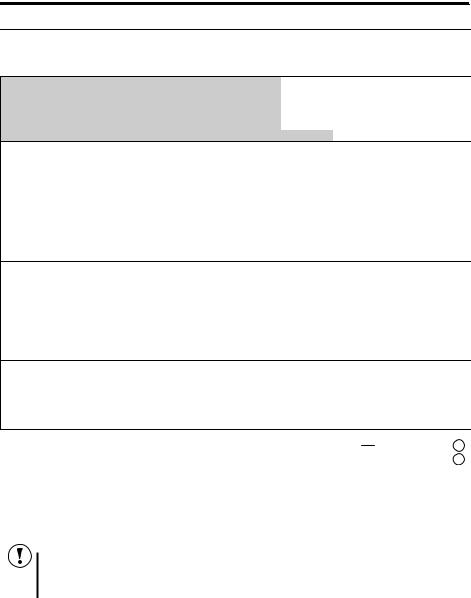
Peripheral devices 
2.1Peripheral devices
Check the inverter model of the inverter you purchased. Appropriate peripheral devices must be selected according to the capacity. Refer to the following list and prepare appropriate peripheral devices.
Single-Phase 200V Three-Phase 400V Three-Phase 200V
|
|
|
Moulded Case Circuit Breaker |
Magnetic Contactor (MC) |
|
|
|
|
|
|
|
|
||||
|
|
Motor |
|
(MCCB) |
|
Reactor |
|
|
||||||||
Applicable Inverter |
or Earth Leakage Circuit Breaker |
|
|
|
|
|||||||||||
Output |
|
|
|
|
|
|
|
|
||||||||
|
Model |
|
(ELB) |
|
|
|
|
|
|
|
|
|
|
|
||
|
(kW) |
|
|
|
|
|
|
|
|
|
|
|
|
|||
|
|
Reactor connection |
Reactor connection |
|
FR-HAL |
FR-HEL |
|
|
||||||||
|
|
|
|
|
|
|||||||||||
|
|
|
without |
|
with |
without |
with |
|
|
|
|
|
|
|
|
|
|
FR-E720-0.1KSC |
0.1 |
5A |
|
5A |
S-N10 |
S-N10 |
|
0.4K |
0.4K |
|
|
||||
|
FR-E720-0.2KSC |
0.2 |
5A |
|
5A |
S-N10 |
S-N10 |
|
0.4K |
0.4K |
|
|
||||
|
FR-E720-0.4KSC |
0.4 |
5A |
|
5A |
S-N10 |
S-N10 |
|
0.4K |
|
0.4K |
|
|
|||
|
FR-E720-0.75KSC |
0.75 |
10A |
|
10A |
S-N10 |
S-N10 |
|
0.75K |
0.75K |
|
|
||||
|
FR-E720-1.5KSC |
1.5 |
15A |
|
15A |
S-N10 |
S-N10 |
|
1.5K |
|
1.5K |
|
|
|||
|
|
|||||||||||||||
|
FR-E720-2.2KSC |
2.2 |
20A |
|
15A |
S-N10 |
S-N10 |
|
2.2K |
|
2.2K |
|
2 |
|||
|
FR-E720-3.7KSC |
3.7 |
30A |
|
30A |
S-N20, S-N21 |
S-N10 |
|
3.7K |
|
3.7K |
|
||||
|
|
|
|
|
|
|||||||||||
|
FR-E720-5.5KSC |
5.5 |
50A |
|
40A |
S-N25 |
S-N20, S-N21 |
|
5.5K |
|
5.5K |
|
|
|||
|
FR-E720-7.5KSC |
7.5 |
60A |
|
50A |
S-N25 |
S-N25 |
|
7.5K |
|
7.5K |
|
|
|||
|
FR-E720-11KSC |
11 |
75A |
|
75A |
S-N35 |
S-N35 |
|
11K |
|
11K |
|
|
|||
|
FR-E720-15KSC |
15 |
125A |
|
100A |
S-N50 |
S-N50 |
|
15K |
|
15K |
|
|
|||
|
FR-E740-0.4KSC |
0.4 |
5A |
|
5A |
S-N10 |
S-N10 |
|
H0.4K |
H0.4K |
|
|
||||
|
FR-E740-0.75KSC |
0.75 |
5A |
|
5A |
S-N10 |
S-N10 |
|
H0.75K |
H0.75K |
|
|
||||
|
FR-E740-1.5KSC |
1.5 |
10A |
|
10A |
S-N10 |
S-N10 |
|
H1.5K |
H1.5K |
|
|
||||
|
FR-E740-2.2KSC |
2.2 |
15A |
|
10A |
S-N10 |
S-N10 |
|
H2.2K |
H2.2K |
|
|
||||
|
FR-E740-3.7KSC |
3.7 |
20A |
|
15A |
S-N10 |
S-N10 |
|
H3.7K |
H3.7K |
|
|
||||
|
FR-E740-5.5KSC |
5.5 |
30A |
|
20A |
S-N20, S-N21 |
S-N11, S-N12 |
|
H5.5K |
H5.5K |
|
|
||||
|
FR-E740-7.5KSC |
7.5 |
30A |
|
30A |
S-N20, S-N21 |
S-N20, S-N21 |
|
H7.5K |
H7.5K |
|
|
||||
|
FR-E740-11KSC |
11 |
50A |
|
40A |
S-N20, S-N21 |
S-N20, S-N21 |
|
H11K |
|
H11K |
|
|
|||
|
FR-E740-15KSC |
15 |
60A |
|
50A |
S-N25 |
S-N20, S-N21 |
|
H15K |
H15K |
|
|
||||
|
FR-E720S-0.1KSC |
0.1 |
5A |
|
5A |
S-N10 |
S-N10 |
|
0.4K |
0.4K |
|
|
||||
|
FR-E720S-0.2KSC |
0.2 |
5A |
|
5A |
S-N10 |
S-N10 |
|
0.4K |
0.4K |
|
|
||||
|
FR-E720S-0.4KSC |
0.4 |
10A |
|
10A |
S-N10 |
S-N10 |
|
0.75K |
0.75K |
|
|
||||
|
FR-E720S-0.75KSC |
0.75 |
15A |
|
10A |
S-N10 |
S-N10 |
|
1.5K |
1.5K |
|
|
||||
|
FR-E720S-1.5KSC |
1.5 |
20A |
|
20A |
S-N10 |
S-N10 |
|
2.2K |
2.2K |
|
|
||||
|
FR-E720S-2.2KSC |
2.2 |
40A |
|
30A |
S-N20, S-N21 |
S-N10 |
|
3.7K |
3.7K |
|
|
||||
|
Select an MCCB according to the power supply capacity. |
|
|
|
|
|
|
|
|
|
|
|
|
|
||
|
Install one MCCB per inverter. |
|
|
|
|
|
|
|
MCCB |
|
INV |
|
IM |
|
||
|
|
|
|
|
|
|
|
|
|
|
|
|
|
|
||
|
|
|
|
|
|
|
|
|
|
MCCB |
|
INV |
|
IM |
|
|
For the use in the United States or Canada, select a UL and cUL certified fuse with Class T fuse equivalent cut-off
speed or faster with the appropriate rating for branch circuit protection. Alternatively, select a UL489 molded case circuit breaker (MCCB). (Refer to page 52) Magnetic contactor is selected based on the AC-1 class. The electrical durability of magnetic contactor is 500,000 times. When the magnetic contactor is used for emergency stop during motor driving, the electrical durability is 25 times.
When using the MC for emergency stop during motor driving or using on the motor side during commercial-power supply operation, select the MC with class AC-3 rated current for the motor rated current.
The power factor may be slightly lower.
NOTE
When the inverter capacity is larger than the motor capacity, select an MCCB and a magnetic contactor according to the inverter model and cable and reactor according to the motor output.
When the breaker on the inverter input side trips, check for the wiring fault (short circuit), damage to internal parts of the inverter, etc. Identify the cause of the trip, then remove the cause and power ON the breaker.
7
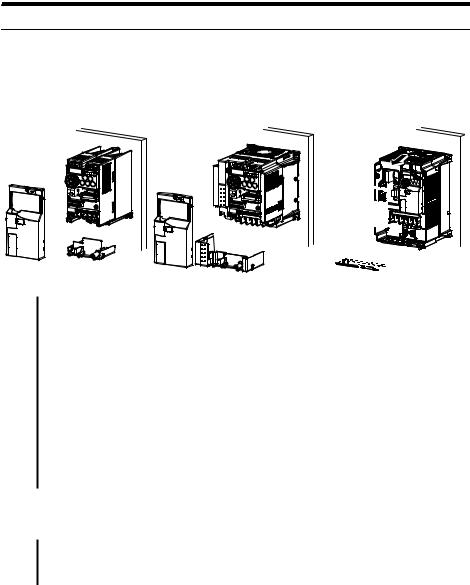
 Installation of the inverter and instructions
Installation of the inverter and instructions
2.2Installation of the inverter and instructions
(1)Installation of the inverter
Enclosure surface mounting
Remove the front cover and wiring cover to fix the inverter to the surface. (Remove the covers in the directions of the arrows.)
FR-E720-0.1KSC to 0.75KSC |
FR-E720-1.5KSC to 3.7KSC |
|
FR-E720-5.5KSC to 15KSC |
FR-E720S-0.1KSC to 0.4KSC |
FR-E740-0.4KSC to 7.5KSC |
|
FR-E740-11KSC, 15KSC |
|
FR-E720S-0.75KSC or higher |
|
|
Front cover |
|
|
|
|
Front cover |
|
|
|
|
Front cover 1 |
|
Wiring cover |
|
Wiring cover |
Wiring cover |
|
|
|
|
Note
When encasing multiple inverters, install them in parallel as a cooling measure.
Install the inverter vertically.
For heat dissipation and maintenance, take at least the clearances shown in the table below from the inverter to the other devices and to the enclosure surface.
|
Measurement |
10cm or more |
|
||
|
position |
|
|
||
5cm |
5cm |
|
|
|
|
|
|
1cm or |
1cm or |
1cm or |
|
|
5cm |
more 1, 2 |
more 1, 2 |
||
Measurement |
more 1 |
||||
|
|
|
|||
position |
10cm or more |
Refer |
|
|
to the |
|
|
|
clearancesthe |
|
show |
n on |
left. |
|
|
|
Vertical
-10 C to 50 C (non-freezing)
Take 5cm or more clearances for 5.5K or higher.
When using the inverters at the surrounding air temperature of 40 C or less, the inverters can be installed without any clearance between them (0cm clearance).
(2)Environment
Before installation, check that the environment meets the specifications on page 47.
Note
Install the inverter on a strong surface securely and vertically with bolts.
Leave enough clearances and take cooling measures.
Avoid places where the inverter is subjected to direct sunlight, high temperature and high humidity.
Install the inverter on a nonflammable wall surface.
8
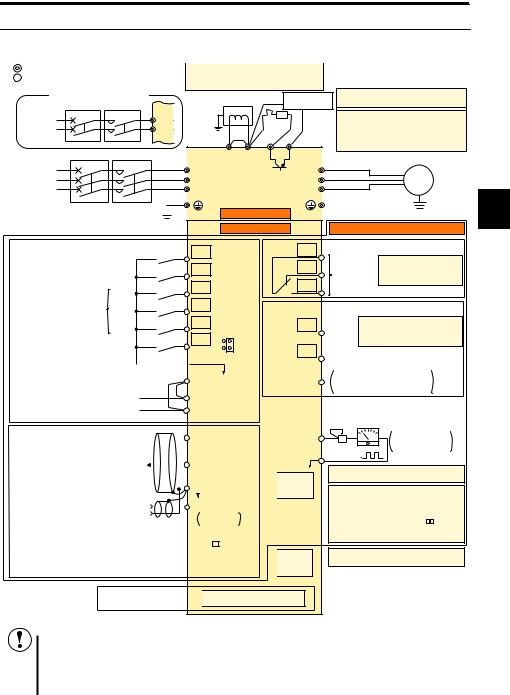
Wiring 
2.3Wiring
2.3.1Terminal connection diagram
Sink logic |
|
Main circuit terminal |
*1. DC reactor (FR-HEL) |
Control circuit terminal |
When connecting a DC reactor, remove the |
jumper across P1 and P/+.
Single-phase power input
MCCB |
MC |
|
Single-phase |
R/L1 |
|
AC power |
S/L2 |
|
supply |
||
|
MCCB MC
Three-phase AC power supply
Earth  (Ground)
(Ground)
Brake unit (Option)
*1
R
Earth |
*7 |
|
(Ground) |
||
|
Jumper |
|
PR |
N/- |
P1 |
P/+ |
*6 |
|
R/L1 |
U |
S/L2 |
V |
T/L3 |
W |
Main circuit
Control circuit
*6 A brake transistor is not built-in to the 0.1K and 0.2K.
*7 Brake resistor (FR-ABR, MRS, MYS type) Install a thermal relay to prevent an overheat and burnout of the brake resistor. (The brake resistor can not be connected to the 0.1K and 0.2K.)
Motor
IM
2
Earth (Ground)
Safety stop function model
Control input signals (No voltage input allowed)
|
Terminal functions vary |
Forward |
|
|
rotation start |
||
|
with the input terminal |
Reverse |
|
|
assignment (Pr. 178 to |
||
|
rotation start |
||
|
Pr. 182 and Pr. 184) |
||
|
|
High |
|
|
|
|
speed |
|
Multi-speed selection Middle |
||
|
|
|
speed |
|
*2 When using terminals PC- |
Low |
|
|
SD as a 24VDC power |
|
|
|
|
speed |
|
|
supply, take care not to |
|
|
|
|
|
|
|
short across terminals |
|
Reset |
|
PC-SD. |
|
|
|
|
|
|
|
|
|
|
Contact input common 
24VDC power supply
(Common for external power supply transistor) Safety stop input common terminal
Safety stop input (Channel 1)
Safety stop input (Channel 2)
Shorting wire
STF
STR
RH
RM
RL
SD |
SOURCE |
SINK |
RES |
|
|
PC *2
S1
S2
|
Frequency setting signals (Analog) |
|
|
|
|
|
|
|
|
|
|
|
|
|
|
|
|
|
||
|
|
Frequency |
3 |
|
|
|
|
|
|
10(+5V) |
|
|
|
|
|
|||||
|
*3 Terminal input specifications |
|
|
|
|
|
|
|
|
|
|
|
|
|
|
|
|
|
||
|
can be changed by analog |
setting |
|
|
|
|
|
|
|
|
|
|
|
|
|
|
|
|
|
|
|
input specifications |
|
|
|
|
|
2 |
|
|
|
2 |
0 to 5VDC |
|
*3 |
|
|||||
|
potentiometer |
|
|
|
|
(0 to 10VDC) |
||||||||||||||
|
switchover (Pr. 73). |
|
|
|
|
|
|
|
|
|
||||||||||
|
1/2W1kΩ |
|
|
|
|
|
|
|
|
|
|
|
||||||||
|
|
|
*4 |
|
|
|
|
|
|
|
|
|
|
|
|
|
|
|
|
|
|
*4 It is recommended to use 2W1kΩ |
1 |
|
|
|
|
|
|
5(Analog common) |
|||||||||||
|
when the frequency setting signal |
|
|
|
|
|
|
|
||||||||||||
|
|
|
|
|
|
|
|
|
|
|
|
|
|
|
|
|
|
|
||
|
is changed frequently. |
|
|
|
|
|
|
|
|
|
|
|
|
|
|
|
|
|
|
|
|
|
|
|
|
|
|
|
|
|
|
|
|
|
|
|
|
|
|
|
|
|
Terminal 4 input (+) |
|
|
|
|
|
4 |
4 to 20mADC |
|
|
||||||||||
|
(Current input) (-) |
|
|
|
|
|
|
|
0 to 5VDC |
*5 |
||||||||||
|
*5 Terminal input specifications can be changed by analog |
|
|
|
|
|
0 to 10VDC |
|||||||||||||
|
input specifications switchover (Pr. 267). Set the |
|
|
|
|
|
|
|
|
|
|
|
|
|||||||
|
voltage/current input switch in the "V" position to select |
|
|
|
|
|
|
|
|
|
|
|
|
|||||||
|
voltage input (0 to 5V/0 to10V) and "I" (initial value) to |
|
|
|
V |
|
|
I |
|
|
|
|||||||||
|
select current input (4 to 20mA). |
|
|
|
|
|
|
|
|
|
|
|
|
|
|
|
|
|
||
|
To use terminal 4 (initial setting is current input), set "4" |
|
|
|
Voltage/current |
|
||||||||||||||
|
in any of Pr.178 to Pr.184 (input terminal function selection) |
|
|
|
input switch *5 |
|||||||||||||||
|
to assign the function, and turn ON AU signal. |
|
|
|
|
|
|
|
|
|
|
|
|
|
|
|||||
|
|
Connector for |
|
|
|
|
|
|
|
|
|
|
|
|
|
|
||||
|
|
|
|
|
|
|
|
|
|
|
Option connector |
|||||||||
|
|
|
|
|
|
|
|
|
|
|
||||||||||
|
|
plug-in option connection |
|
|
|
|
|
|
||||||||||||
|
|
|
|
|
|
|
|
|
|
|
|
|
||||||||
C |
|
|
Relay output |
|
B |
|
|
Terminal functions vary |
|
Relay output |
by Pr. 192 A,B,C terminal |
|||
|
||||
|
|
|||
|
(Fault output) |
function selection |
||
A |
|
|||
|
|
|
||
|
|
|
Open collector output |
|
RUN |
|
Terminal functions vary with |
||
|
|
|
||
|
Running |
the output terminal assignment |
||
|
|
|
||
|
|
(Pr. 190 and Pr. 191) |
||
FU |
|
|
|
|
|
Frequency detection |
|||
SE |
Open collector output common |
|||
|
Sink/source common |
|||
Calibration resistor
Indicator
+- (Frequency meter, etc.)
FM |
|
Moving-coil type |
|
1mA full-scale |
|
|
*8 |
|
SD |
|
|
|
|
|
|
*8 |
It is not necessary when calibrating the |
PU |
|
indicator from the operation panel. |
|
|
|
connector |
*9 |
Operation and parameter setting can be |
*9 |
|
done from the parameter unit (FR-PU07) |
|
and the enclosure surface operation panel |
|
|
|
|
|
|
(FR-PA07). |
|
|
(Use the option cable (FR-CB2 ).) |
|
|
RS-485 communication can be utilized from |
|
|
a personal computer and other devices. |
USB |
*10 |
A personal computer and an inverter can be |
|
connected with a USB (Ver1.1) cable. |
|
connector |
|
|
*10
NOTE
To prevent a malfunction caused by noise, separate the signal cables more than 10cm from the power cables. Also separate the main circuit wire of the input side and the output side.
After wiring, wire offcuts must not be left in the inverter.
Wire offcuts can cause an alarm, failure or malfunction. Always keep the inverter clean. When drilling mounting holes in an enclosure etc., take care not to allow chips and other foreign matter to enter the inverter.
The output of the single-phase power input model is three-phase 200V.
9
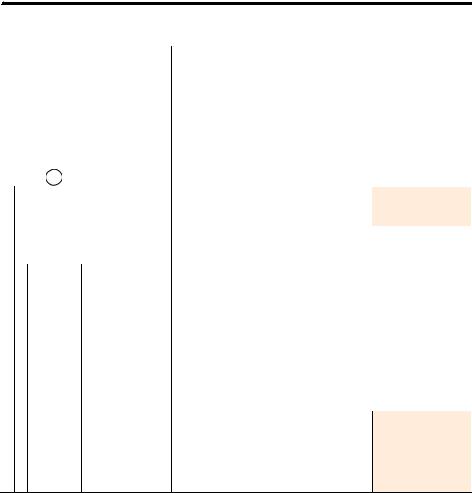
 Wiring
Wiring
2.3.2Terminal specifications
Type |
Terminal |
Terminal Name |
Description |
|
||||
Symbol |
|
|||||||
|
|
|
|
|
||||
|
|
R/L1, S/L2, |
AC power input |
Connect to the commercial power supply. Keep these terminals open when using the high |
||||
|
|
power factor converter (FR-HC) or power regeneration common converter (FR-CV). |
||||||
|
|
T/L3 * |
||||||
|
|
|
When using single-phase power input, terminals are R/L1 and S/L2. |
|||||
|
|
|
|
|
|
|
||
|
|
U, V, W |
Inverter output |
Connect a three-phase squirrel-cage motor. |
|
|||
circuit |
P/+, PR |
Brake resistor connection |
Connect a brake resistor (MRS type, MYS type, FR-ABR) across terminals P/+ and PR. |
|||||
|
|
|
|
|
(The brake resistor can not be connected to the 0.1K or 0.2K) |
|
||
Main |
|
|
|
|
Brake unit connection |
Connect the brake unit (FR-BU2), power regeneration common converter (FR-CV) or high |
||
P/+, N/- |
power factor converter (FR-HC). |
|
||||||
|
|
|||||||
|
|
|
|
|
|
DC power input |
Connect the plus side of the power supply to terminal P/+ and minus side to terminal N/-. |
|
|
|
P/+, P1 |
DC reactor connection |
Remove the jumper across terminals P/+ and P1 and connect a DC reactor. |
||||
|
|
|
|
|
|
Earth (Ground) |
For earthing (grounding) the inverter chassis. Must be earthed (grounded). |
|
|
|
|
|
|
|
|||
|
|
|
|
|
|
|
|
|
|
|
STF |
Forward rotation start |
Turn ON the STF signal to start forward rotation and turn it OFF |
When the STF and STR |
|||
|
|
to stop. |
signals are turned ON |
|||||
|
|
|
|
|
|
|
||
|
|
STR |
Reverse rotation start |
Turn ON the STR signal to start reverse rotation and turn it OFF |
simultaneously, the stop |
|||
|
|
to stop. |
command is given. |
|||||
|
|
|
|
|
|
|
||
|
|
RH, RM, RL |
Multi-speed selection |
Multi-speed can be selected according to the combination of RH, RM and RL signals. |
||||
|
|
RES |
Reset |
Used to reset alarm output provided when protective circuit is activated. Turn ON the RES |
||||
|
|
signal for more than 0.1s, then turn it OFF. Initial setting is for reset always. By setting Pr. 75, |
||||||
|
|
|
|
|
|
|
reset can be set to enabled only at fault occurrence. Recover about 1s after reset is cancelled. |
|
|
|
|
|
|
|
Contact input common |
Common terminal for contact input terminal (sink logic) and terminal FM. |
|
|
input |
|
|
|
|
(sink) (initial setting) |
||
|
|
|
|
|
|
|
||
|
|
|
|
|
External transistor |
Connect this terminal to the power supply common terminal of a transistor output (open |
||
signalcircuit/input Contact |
|
SD |
collector output) device, such as a programmable controller, in the source logic to avoid |
|||||
|
common (source) |
|||||||
|
|
|
|
malfunction by undesirable current. |
|
|||
|
|
|
|
|
|
|
||
|
|
|
|
|
|
|
|
|
|
|
|
|
|
|
24VDC power supply |
Common output terminal for 24VDC 0.1A power supply (PC terminal). |
|
|
|
|
|
|
|
common |
Isolated from terminals 5 and SE. |
|
|
|
|
|
|
|
External transistor |
Connect this terminal to the power supply common terminal of a transistor output (open |
|
|
|
|
|
|
|
common |
collector output) device, such as a programmable controller, in the sink logic to avoid |
|
Control |
|
|
|
|
(sink) (initial setting) |
malfunction by undesirable current. |
|
|
|
|
|
PC |
Contact input common |
Common terminal for contact input terminal (source logic). |
|
||
|
|
|
(source) |
|
||||
|
|
|
|
|
|
24VDC power supply |
Can be used as 24VDC 0.1A power supply. |
|
|
|
|
|
|
|
Safety stop input terminal |
Common terminal for safety stop input terminals S1 and S2. |
|
|
|
|
|
|
|
common |
|
|
* |
|
|
|
|
|
S1/S2 are safety stop signals for use with in conjunction with |
|
|
|
function |
|
S1 |
Safety stop input |
an approved external safety unit. Both S1/S2 must be used in |
Input resistance 4.7k |
||
|
|
open |
||||||
|
|
|
|
|
|
(Channel 1) |
dual channel form. Inverter output is shutoff depending on |
Voltage when contacts are |
|
|
|
|
|
|
|
shorting/opening between S1 and PC, S2 and PC. |
21 to 26VDC |
|
stop |
|
|
|
|
|
In the initial status, terminal S1 and S2 are shorted with |
|
|
|
|
|
|
|
When contacts are short- |
||
|
Safety |
|
S2 |
Safety stop input |
terminal PC by shorting wire. |
circuited |
||
|
|
|
|
|
(Channel 2) |
when using the safety stop function. |
4 to 6mADC |
|
|
|
|
|
|
|
Remove the shorting wire and connect the safety relay module |
|
|
|
|
|
|
|
|
|
|
|
For more details, refer to the Safety stop function instruction manual (BCN-A211508-004). (Refer to the front cover for how to obtain the manual.)
10
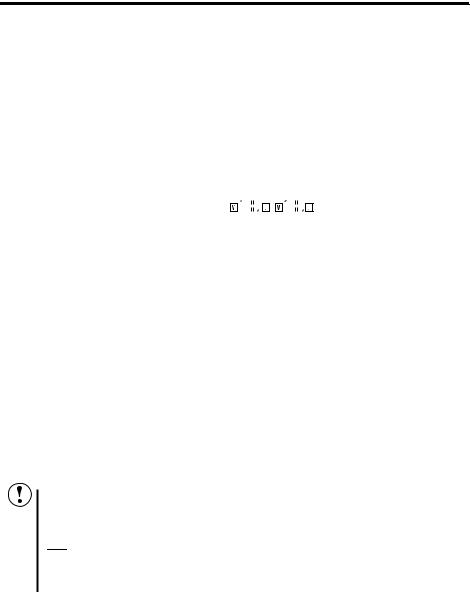
Wiring 
Type |
Terminal |
Terminal Name |
|
|
|
|
|
|
Description |
|
|
|
||
Symbol |
|
|
|
|
|
|
|
|
|
|||||
|
|
|
|
|
|
|
|
|
|
|
|
|
|
|
|
|
10 |
Frequency setting power |
Used as power supply when connecting potentiometer for |
5VDC |
|
|
|||||||
|
|
supply |
frequency setting (speed setting) from outside of the inverter. |
permissible load current 10mA |
|
|
||||||||
|
|
|
|
|||||||||||
|
|
|
Frequency setting |
Inputting 0 to 5VDC (or 0 to 10V) provides the maximum output |
Input resistance 10k ± 1k |
|
|
|||||||
|
|
2 |
frequency at 5V (10V) and makes input and output |
Permissible maximum voltage |
|
|
||||||||
|
|
(voltage) |
proportional. Use Pr. 73 to switch between input 0 to 5VDC |
|
||||||||||
|
|
|
20VDC |
|
|
|||||||||
|
|
|
|
(initial setting) and 0 to 10VDC input. |
|
|
||||||||
circuit/inputControlsignal |
|
|
|
|
|
|
|
|||||||
|
|
|
Inputting 0 to 20mADC (or 0 to 5V / 0 to 10V) provides the |
|
|
|
||||||||
settingFrequency |
|
|
maximum output frequency at 20mA and makes input and |
|
|
|
||||||||
|
|
output proportional. This input signal is valid only when the AU |
Maximum permissible current |
|
|
|||||||||
|
|
signal is ON (terminal 2 input is invalid). To use terminal 4 |
|
|||||||||||
|
|
|
|
Voltage input: |
|
|||||||||
|
|
|
|
(initial setting is current input), set "4" to any of Pr.178 to Pr.184 |
Input resistance 10k ± 1k |
|
||||||||
|
|
|
Frequency setting |
(input terminal function selection), and turn AU signal ON. Use |
Permissible maximum voltage |
|
||||||||
|
|
4 |
Pr. 267 to switch among input 4 to 20mA (initial setting), 0 to |
20VDC |
|
|||||||||
|
|
|
(current) |
5VDC, and 0 to 10VDC. Set the voltage/current input switch in |
Current input: |
|
||||||||
|
|
|
|
the "V" position to select voltage input (0 to 5V/0 to 10V). |
Input resistance 233 ± 5 |
|
||||||||
|
|
|
|
Current input |
|
30mA. |
|
|||||||
|
|
|
|
(initial status) Voltage input |
|
|
|
|
||||||
|
|
|
|
|
|
|
|
|
|
|
|
|
|
2 |
|
|
|
|
|
|
|
|
|
|
|
|
|
|
|
|
|
5 |
Frequency setting |
Common terminal for the frequency setting signals (terminals 2 and 4). Do not earth (ground). |
|
|
||||||||
|
|
|
common |
|
|
|
|
|
|
|
|
|
|
|
|
Relay |
|
Relay output |
1 changeover contact output indicates that the inverter fault occurs. |
|
|
||||||||
|
A, B, C |
Fault: discontinuity across B and C (continuity across A and C), |
|
|
|
|||||||||
|
(fault output) |
Normal: continuity across B and C (discontinuity across A and C) |
|
|||||||||||
|
|
|
|
Contact capacity 230VAC 0.3A (power factor = 0.4) 30VDC 0.3A |
|
|||||||||
signal |
|
RUN |
Inverter running |
Switched Low when the inverter output frequency is equal to or |
Permissible load 24VDC |
|
|
|||||||
|
Switched High during stop or DC injection brake operation. |
(a voltage drop is 3.4V |
|
|||||||||||
|
|
higher than the starting frequency (initial value 0.5Hz). |
(Maximum 27VDC) 0.1A |
|
||||||||||
circuit/outputControl |
collectorOpen |
|
|
|
|
|
|
|
|
|
|
maximum when the signal is |
|
|
SE |
Open collector |
Common terminal of terminal RUN and FU. |
|
|
|
|||||||||
|
ON) |
|
|
|||||||||||
|
|
|
|
Switched Low when the inverter output frequency is equal to or |
|
|||||||||
|
|
FU |
Frequency detection |
Low is when the open |
|
|||||||||
|
|
higher than the preset detected frequency and High when less |
collector output transistor is |
|
||||||||||
|
|
|
|
than the preset detected frequency. |
|
ON (conducts). High is when |
|
|||||||
|
|
|
|
|
|
|
|
|
|
|
|
the transistor is OFF (does |
|
|
|
|
|
|
|
|
|
|
|
|
|
|
not conduct). |
|
|
|
|
|
output common |
|
|
|
|
|
|
|
|
|
|
|
|
Pulse |
|
|
Used to output a selected monitored item (such as Output |
Permissible load current 1mA |
|
|
|||||||
|
FM |
For meter |
frequency) among several monitored items. (Not output during |
|
||||||||||
|
inverter reset.) The output signal is proportional to the |
1440 pulses/s at 60Hz |
|
|||||||||||
|
|
|
|
magnitude of the corresponding monitoring item. |
|
|
|
|||||||
Communication |
— |
PU connector |
With the PU connector, RS-485 communication can be established. |
|
|
|||||||||
· Connector: USB mini B connector (receptacle mini B type) |
|
|
|
|||||||||||
|
|
· Conforming standard: EIA-485 (RS-485) |
· Transmission format: Multi-drop link |
|
||||||||||
|
|
|
|
· Communication speed: 4800 to 38400bps |
· Overall extension: 500m |
|
||||||||
|
|
— |
USB connector |
A personal computer and an inverter can be connected with a USB (Ver1.1) cable. |
|
|
||||||||
|
|
· Interface: conforms to USB1.1 |
· Transmission Speed: 12Mbps |
|
||||||||||
|
|
|
|
|
|
|
|
|
|
|
|
|
|
|
Note
Set Pr. 267 and a voltage/current input switch correctly, then input an analog signal in accordance with the setting. Applying a voltage with voltage/current input switch in "I" position (current input is selected) or a current with switch in "V" position (voltage input is selected) could cause component damage of the inverter or analog circuit of output devices.
The inverter will be damaged if power is applied to the inverter output terminals (U, V, W). Never perform such wiring.

 indicates that terminal functions can be selected using Pr. 178 to Pr. 182, Pr. 184 and Pr. 190 to Pr. 192 (I/O terminal function selection).
indicates that terminal functions can be selected using Pr. 178 to Pr. 182, Pr. 184 and Pr. 190 to Pr. 192 (I/O terminal function selection).
Terminal names and terminal functions are those of the factory set.
When connecting the DC power supply, be sure to connect the plus side of the power supply to terminal P/+ and minus side to terminal N/-. Opposite polarity will damage the inverter.
11
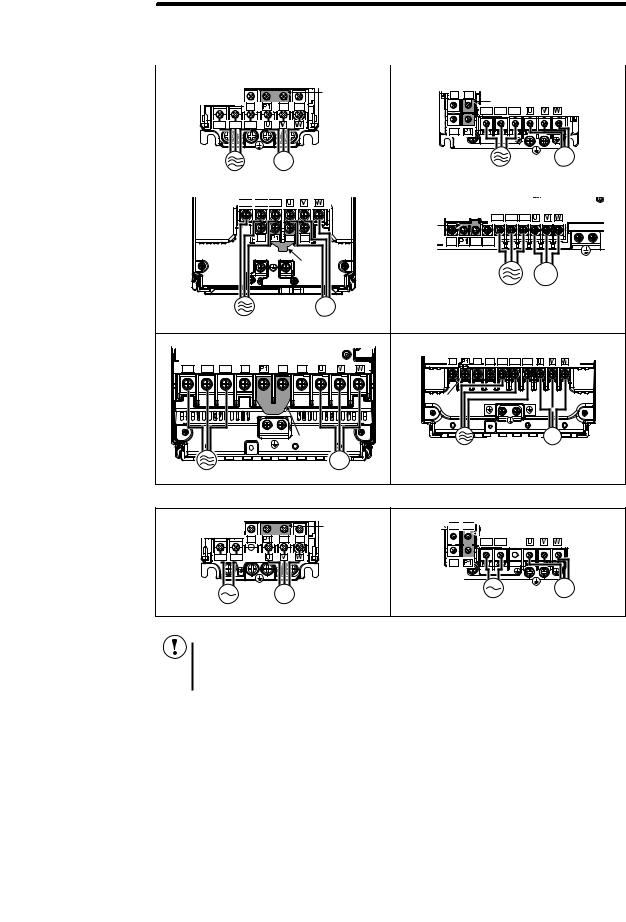
 Wiring
Wiring
2.3.3Terminal arrangement of the main circuit terminal, power supply and the motor wiring
Three-phase 200V/400V class
FR-E720-0.1KSC to 0.75KSC |
FR-E720-1.5KSC to 3.7KSC |
|
FR-E740-0.4KSC to 3.7KSC |
|
|
|
Jumper |
N/- P/+ |
|
|
|
|
|
N/- |
P/+ |
PR |
|
Jumper |
|
R/L1 S/L2 T/L3 |
|||
|
|
|
|
R/L1 S/L2 T/L3 |
PR |
|
IM |
|
IM |
|
|
|
|
Power supply |
Motor |
Power supply |
Motor |
|
|
FR-E720-5.5KSC, 7.5KSC |
FR-E740-5.5KSC, 7.5KSC |

 R/L1
R/L1
 S/L2
S/L2
 T/L3
T/L3
R/L1 S/L2 |
T/L3 |
Jumper |
|
N/- |
P/+ |
PR |
N/- |
P/+ PR |
|
|
|
|
Jumper |
|
IM |
|
Power supply Motor |
|
IM |
Power supply |
Motor |
FR-E720-11KSC, 15KSC |
FR-E740-11KSC, 15KSC |
|
|
N/- |
P/+ |
PR |
R/L1 S/L2 T/L3 |
R/L1 S/L2 T/L3 N/- |
P/+ |
PR |
|
|
|
Jumper
Jumper |
IM |
Power supply |
Motor |
IM

Power supply |
Motor |
Single-phase 200V class
FR-E720S-0.1KSC to 0.4KSC
Jumper
N/- |
P/+ |
PR |
R/L1 S/L2 |
|
IM |
Power supply |
Motor |
FR-E720S-0.75KSC to 2.2KSC

 N/-
N/-
 P/+
P/+









 Jumper
Jumper














 R/L1 S/L2
R/L1 S/L2
PR |
IM
Power supply |
Motor |
NOTE
Make sure the power cables are connected to the R/L1, S/L2, and T/L3. (Phase need not be matched.) Never connect the power cables to the U, V, and W of the inverter. Doing so will damage the inverter.
Connect the motor to U, V, and W. Turning ON the forward rotation switch (signal) at this time rotates the motor counterclockwise when viewed from the load shaft.
12
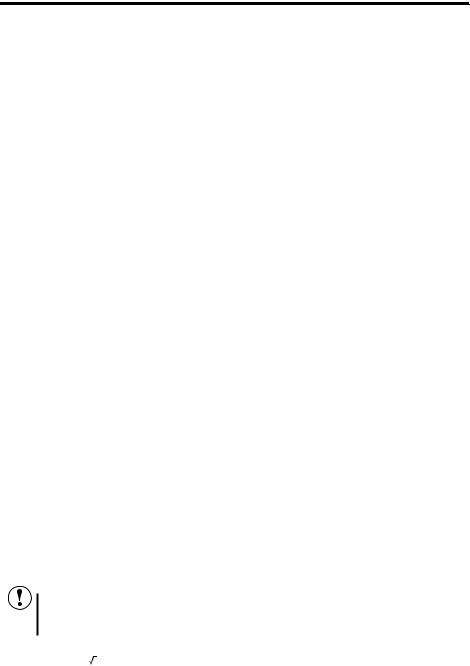
Wiring 
(1)Cable size and other specifications of the main circuit terminals and the earthing terminal
Select the recommended cable size to ensure that a voltage drop will be 2% or less.
If the wiring distance is long between the inverter and motor, a main circuit cable voltage drop will cause the motor torque to decrease especially at the output of a low frequency.
The following table indicates a selection example for the wiring length of 20m.
Three-phase 200V class (when input power supply is 220V)
|
|
|
Crimping |
|
|
|
Cable Size |
|
|
|
|
|
||
Applicable Inverter |
Terminal |
Tightening |
Terminal |
HIV Cables, etc. (mm2) |
AWG |
PVC Cables, etc. (mm2) |
|
|
||||||
Screw |
Torque |
|
|
|
|
|
|
|
|
|
|
|
|
|
Model |
Size |
N·m |
R/L1 |
U, V, W |
R/L1 |
U, V, W |
Earthing |
R/L1 |
U, V, W |
R/L1 |
U, V, W |
Earthing |
|
|
|
|
|
||||||||||||
|
|
|
S/L2 |
S/L2 |
cable |
S/L2 |
S/L2 |
cable |
|
|
||||
|
|
|
T/L3 |
|
T/L3 |
|
T/L3 |
|
T/L3 |
|
|
|
||
|
|
|
|
|
|
|
|
|
|
|
||||
FR-E720-0.1KSC to 0.75KSC |
M3.5 |
1.2 |
2-3.5 |
2-3.5 |
2 |
2 |
2 |
14 |
14 |
2.5 |
2.5 |
2.5 |
|
|
FR-E720-1.5KSC, 2.2KSC |
M4 |
1.5 |
2-4 |
2-4 |
2 |
2 |
2 |
14 |
14 |
2.5 |
2.5 |
2.5 |
|
|
FR-E720-3.7KSC |
M4 |
1.5 |
5.5-4 |
5.5-4 |
3.5 |
3.5 |
3.5 |
12 |
12 |
4 |
4 |
4 |
|
|
FR-E720-5.5KSC |
M5 |
2.5 |
5.5-5 |
5.5-5 |
5.5 |
5.5 |
5.5 |
10 |
10 |
6 |
6 |
6 |
|
2 |
FR-E720-7.5KSC |
M5 |
2.5 |
14-5 |
8-5 |
14 |
8 |
5.5 |
6 |
8 |
16 |
10 |
6 |
|
|
FR-E720-11KSC |
M5 |
2.5 |
14-5 |
14-5 |
14 |
14 |
14 |
6 |
6 |
16 |
16 |
16 |
|
|
FR-E720-15KSC |
M6(M5) |
4.4 |
22-6 |
22-6 |
22 |
22 |
14 |
4 |
4 |
25 |
25 |
16 |
|
|
Three-phase 400V class (when input power supply is 440V)
|
|
|
Crimping |
|
|
|
Cable Size |
|
|
|
||
Applicable Inverter |
Terminal |
Tightening |
Terminal |
HIV Cables, etc. (mm2) |
AWG |
PVC Cables, etc. (mm2) |
||||||
Screw |
Torque |
|
|
|
|
|
|
|
|
|
|
|
Model |
Size |
N·m |
R/L1 |
U, V, W |
R/L1 |
U, V, W |
Earthing |
R/L1 |
U, V, W |
R/L1 |
U, V, W |
Earthing |
|
||||||||||||
|
|
|
S/L2 |
S/L2 |
cable |
S/L2 |
S/L2 |
cable |
||||
|
|
|
T/L3 |
|
T/L3 |
|
T/L3 |
|
T/L3 |
|
||
|
|
|
|
|
|
|
|
|
||||
FR-E740-0.4KSC to 3.7KSC |
M4 |
1.5 |
2-4 |
2-4 |
2 |
2 |
2 |
14 |
14 |
2.5 |
2.5 |
2.5 |
FR-E740-5.5KSC |
M4 |
1.5 |
5.5-4 |
2-4 |
3.5 |
2 |
3.5 |
12 |
14 |
4 |
2.5 |
4 |
FR-E740-7.5KSC |
M4 |
1.5 |
5.5-4 |
5.5-4 |
3.5 |
3.5 |
3.5 |
12 |
12 |
4 |
4 |
4 |
FR-E740-11KSC |
M4 |
1.5 |
5.5-4 |
5.5-4 |
5.5 |
5.5 |
8 |
10 |
10 |
6 |
6 |
10 |
FR-E740-15KSC |
M5 |
2.5 |
8-5 |
8-5 |
8 |
8 |
8 |
8 |
8 |
10 |
10 |
10 |
Single-phase 200V class (when input power supply is 220V)
|
|
|
Crimping |
|
|
|
Cable Size |
|
|
|
||
Applicable Inverter |
Terminal |
Tightening |
Terminal |
HIV Cables, etc. (mm2) |
AWG |
PVC Cables, etc. (mm2) |
||||||
Model |
Screw |
Torque |
|
|
|
|
|
|
|
|
|
|
|
Size |
N·m |
R/L1 |
U, V, W |
R/L1 |
U, V, W |
Earthing |
R/L1 |
U, V, W |
R/L1 |
U, V, W |
Earthing |
|
|
|
S/L2 |
S/L2 |
cable |
S/L2 |
S/L2 |
cable |
||||
FR-E720S-0.1KSC to 0.4KSC |
M3.5 |
1.2 |
2-3.5 |
2-3.5 |
2 |
2 |
2 |
14 |
14 |
2.5 |
2.5 |
2.5 |
FR-E720S-0.75KSC |
M4 |
1.5 |
2-4 |
2-4 |
2 |
2 |
2 |
14 |
14 |
2.5 |
2.5 |
2.5 |
FR-E720S-1.5KSC |
M4 |
1.5 |
2-4 |
2-4 |
2 |
2 |
2 |
14 |
14 |
2.5 |
2.5 |
2.5 |
FR-E720S-2.2KSC |
M4 |
1.5 |
5.5-4 |
2-4 |
3.5 |
2 |
2 |
12 |
14 |
4 |
2.5 |
2.5 |
The cable size is that of the cable (HIV cable (600V class 2 vinyl-insulated cable) etc.) with continuous maximum permissible temperature of 75°C. Assumes that the surrounding air temperature is 50°C or less and the wiring distance is 20m or less.
The recommended cable size is that of the cable (THHW cable) with continuous maximum permissible temperature of 75°C. Assumes that the surrounding air temperature is 40°C or less and the wiring distance is 20m or less. (Selection example for use mainly in the United States.)
The recommended cable size is that of the cable (PVC cable) with continuous maximum permissible temperature of 70°C. Assumes that the surrounding air temperature is 40°C or less and the wiring distance is 20m or less. (Selection example for use mainly in Europe.)
The terminal screw size indicates the terminal size for R/L1, S/L2, T/L3, U, V, W, and a screw for earthing (grounding). A screw for earthing (grounding) of the FR-E720-15KSC is indicated in ( ).
For single-phase power input, the terminal screw size indicates the size of terminal screw for R/L1, S/L2, U, V, W, PR, P/+, N/-, P1 and a screw for earthing (grounding).
NOTE
Tighten the terminal screw to the specified torque. A screw that has been tighten too loosely can cause a short circuit or malfunction. A screw that has been tighten too tightly can cause a short circuit or malfunction due to the unit breakage.
Use crimping terminals with insulation sleeve to wire the power supply and motor.
The line voltage drop can be calculated by the following formula:
Line voltage drop [V]= |
3 × wire resistance[mΩ/m] × wiring distance[m] × current[A] |
|
1000 |
||
|
Use a larger diameter cable when the wiring distance is long or when it is desired to decrease the voltage drop (torque reduction) in the low speed range.
13
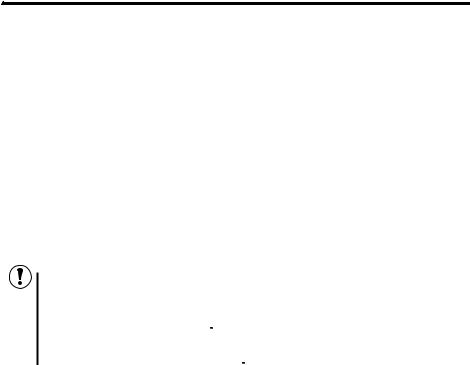
 Wiring
Wiring
(2)Total wiring length
The overall wiring length for connection of a single motor or multiple motors should be within the value in the table below.
Pr. 72 PWM frequency selection |
|
|
|
|
|
|
3.7K |
|||
Setting |
|
0.1K |
0.2K |
0.4K |
0.75K |
1.5K |
2.2K |
|||
|
or More |
|||||||||
(carrier frequency) |
|
|
|
|
|
|
||||
|
|
|
|
|
|
|
||||
1 (1kHz) or less |
|
|
200V class |
200m |
200m |
300m |
500m |
500m |
500m |
500m |
|
|
400V class |
- |
- |
200m |
200m |
300m |
500m |
500m |
|
|
|
|
||||||||
2 to15 |
|
|
200V class |
30m |
100m |
200m |
300m |
500m |
500m |
500m |
(2kHz to 14.5kHz) |
|
400V class |
- |
- |
30m |
100m |
200m |
300m |
500m |
|
When driving a 400V class motor by the inverter, surge voltages attributable to the wiring constants may occur at the motor terminals, deteriorating the insulation of the motor. Take the following measures 1) or 2) in this case.
1) |
Use a "400V class inverter-driven insulation-enhanced motor" and set frequency in Pr. 72 PWM frequency selection |
|||||
|
according to wiring length. |
|
|
|
|
|
|
|
|
|
|
|
|
|
|
|
|
Wiring Length |
|
|
|
|
|
50m or less |
50m to 100m |
Exceeding 100m |
|
|
Carrier frequency |
|
14.5kHz or less |
8kHz or less |
2kHz or less |
|
2) |
Connect the surge voltage suppression filter (FR-ASF-H/FR-BMF-H) on the inverter output side. |
|||||
NOTE
Especially for long-distance wiring, the inverter may be affected by a charging current caused by the stray capacitances of the wiring, leading to a malfunction of the overcurrent protective function, fast response current limit function, or stall prevention function or a malfunction or fault of the equipment connected on the inverter output side. If malfunction of fast-response current limit function occurs, disable this function. If malfunction of stall prevention
function occurs, increase the stall level. (  Pr. 22 Stall prevention operation level and Pr. 156 Stall prevention operation selection in Chapter 4 of the Instruction Manual (Applied))
Pr. 22 Stall prevention operation level and Pr. 156 Stall prevention operation selection in Chapter 4 of the Instruction Manual (Applied))
When using the automatic restart after instantaneous power failure function with the wiring length exceeding 100m, select without frequency search (Pr. 162 = "1, 11"). (  Refer to Chapter 4 of the Instruction Manual (Applied))
Refer to Chapter 4 of the Instruction Manual (Applied))
14
